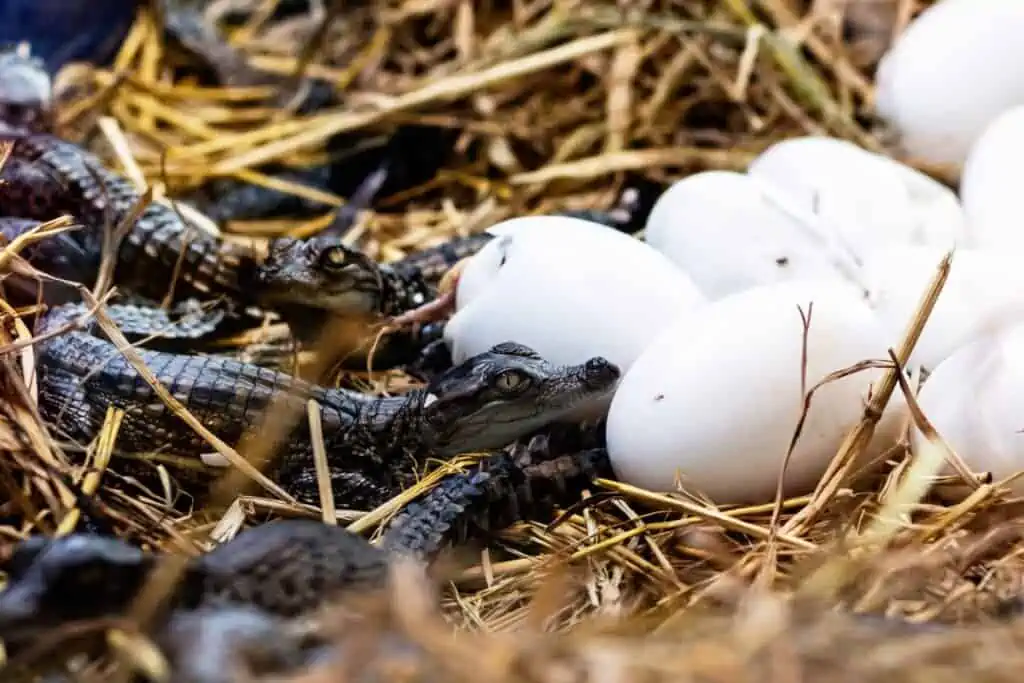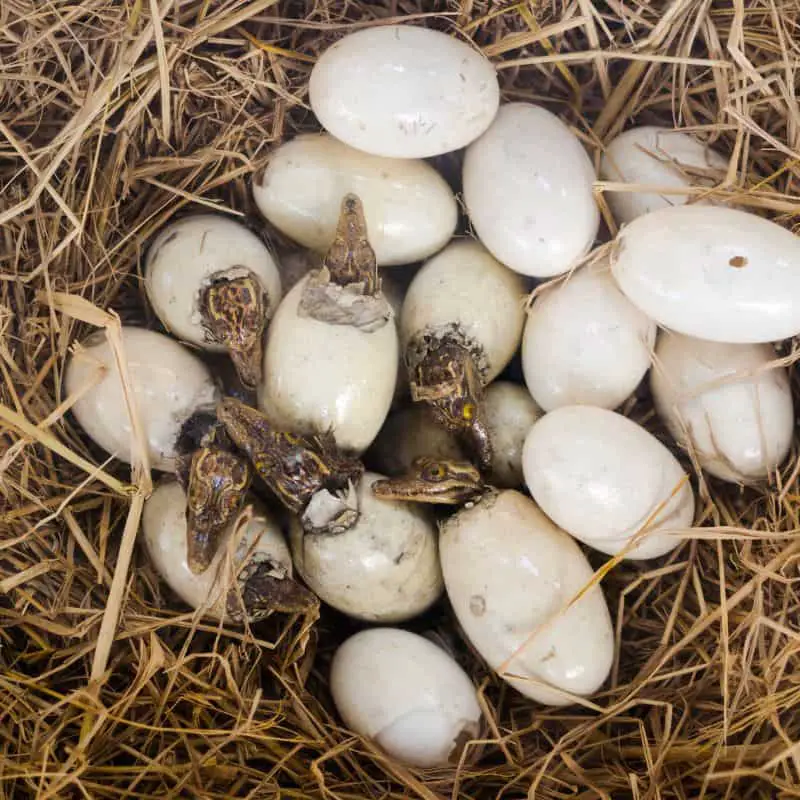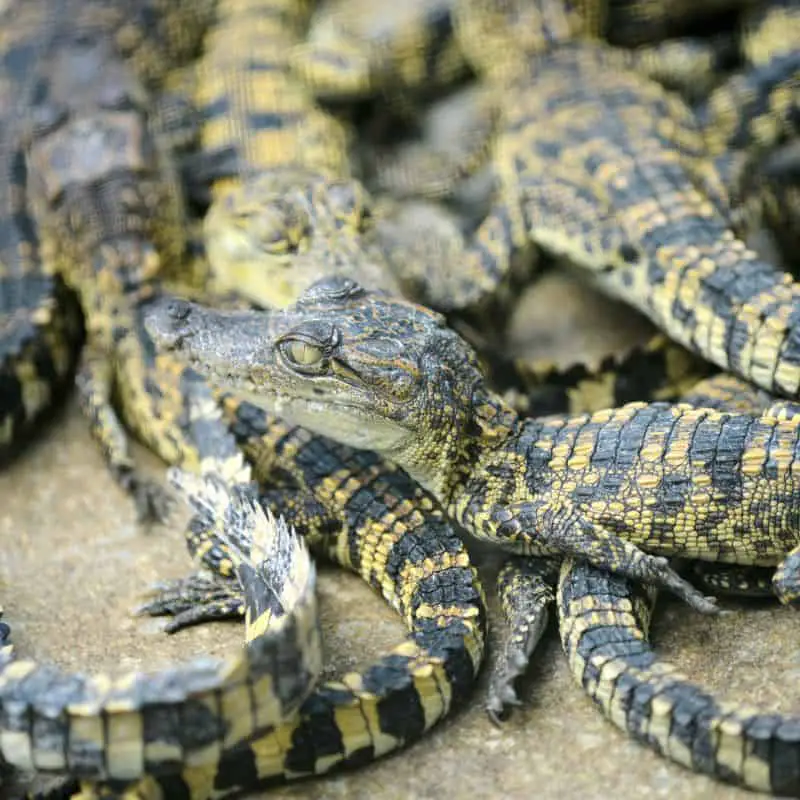Crocodiles are some of the most interesting reptiles in the animal kingdom. They have been around for millions of years and can live in various habitats. But do crocodiles lay eggs?
All species of crocodiles lay eggs, and most species lay an average of between 12 and 48 eggs, but some species can lay more than 60 at a time. Female crocodiles will carefully plan and excavate their nests near water sources and remain nearby to protect their eggs.
For the crocodile species to survive, breeding must occur, and youngsters must be hatched. The cycle starts with the crocodile’s mating, followed by the laying of eggs, incubation, and the emergence of hatchlings.
But the physical characteristics, placement, and environmental conditions of eggs and nests play a pivotal role in ensuring that crocodile hatchlings live long enough to become parents themselves.

The Breeding Habits Of Crocodiles
Crocodiles reach sexual maturity around age ten and between 5 to 10 feet in length, and male crocodiles will seek to mate with as many females as they can during their breeding season.
To win the affection of the local females, males will engage in showcases of slapping the water with their snouts and wrestling matches.
Victorious males win the right to mate with receptive females, and when they are ready, the pair wrap around each other and join together in the water.
Crocodiles lay eggs roughly once a year, a couple of months after mating. Females lay large clutches of eggs in their nests during the night and bury them in the soil to offer protection and necessary heat to encourage faster hatching.
The number of eggs a crocodile lays averages between 12 and 48 but varies by species. Larger crocodile species lay more eggs than smaller ones, with Dwarf crocodiles laying only between 10 to 20 eggs and Saltwater crocodiles potentially laying more than 60.
After the eggs hatch, the crocodiles will spend a brief period protecting their hatchlings until they become roughly independent.
In many species, adult crocodiles will respond to cries for help from younglings for around six months after they hatch.
Physical Characteristics Of Crocodile Eggs

Crocodile eggs have hard protective outer casings and softer internal membranes, similar to birds’ eggs.
While they are imperceptible, there are microscopic holes across the surface of crocodile eggs that allow for the absorption of oxygen and water into the egg to sustain the embryos inside.
Crocodile eggs are around the same size and weight as large chicken eggs but are slightly elongated rather than oval and have smooth, thick, cream-colored shells.
Some eggs may be translucent when newly laid, but they gain color as they get closer to hatching.
If minerals are abundant in the female’s body, the eggs she lays can be more robust and durable, while a lack of minerals can lead to eggs with weakened shells.
Crocodile Hatchling Sex Depends On The Area’s Temperature
Genetics often plays a role in determining the characteristics that any particular offspring of an animal will have. Animals may have genes that prefer one specific body shape, color, size, and even gender.
With crocodiles, this is not so.
Genetics is not a significant factor in determining whether any particular individual will be male or female, but this relies on the environmental temperature.
The prevailing weather conditions during the middle portion of the hatching period in the area where crocodiles lay their eggs increase the likelihood that hatchlings are either male or female.
When the temperatures are within the ideal range of around 93 degrees Fahrenheit, baby crocodiles tend to be male, but warmer or colder extremes deliver mostly female crocodiles.
Where Do Crocodiles Lay Their Eggs?
The best places for crocodiles to lay their eggs are close to water sources, on riverbanks, on shores of lakes, pans, marshes, and any other area thick with vegetation.
The nests are not always left on the ground, though. Often, crocodiles dig into the soil for soft, warm nesting locations or build a mound with plant materials and mud.
Sometimes crocodiles will lay all their eggs in the same nest, while at other times, they may lay them in a few different spots in the same area. But the nests are never far apart, and the female crocodile is constantly vigilant against potential poaching.
Naturalists have observed that opportunistic scavengers may destroy up to 90% of crocodile eggs before they are ready to hatch.
Predation is a considerable risk to crocodile eggs, even when attentive parents are around to protect them.
Monitor lizards, bush pigs, snakes, mongooses, and primates such as monkeys and baboons, seek out crocodile nests, and wait for opportunities to steal the eggs.
How Do Crocodiles Take Care Of Their Hatchlings?
Around 2 to 3 months after being laid, crocodile eggs start hatching. The newborn hatchlings will cry for their mother before they emerge from the egg.
When she deposits the eggs, the female crocodile will remain alert as she guards the nest against potential dangers.
Crocodile hatchlings develop ready to break out of their eggs when the incubation period is over.
Each comes armed with a sharpened, thickened portion of skin at the tip of their snout that they can use to puncture the shell.
Sometimes the eggs dry out in the nest and become difficult for the young crocodiles to break through, so their mother will help them crack the shells if they are struggling, gently gather them in her mouth, and move them safely to the nearest water source.
A female crocodile can simultaneously load as many as 15 hatchlings in her mouth without harming any of the hatchlings.
Certain crocodile species lay more than one nest, with a timelapse between depositing the eggs.
Then the female is usually the first to respond to the cries of hatchlings in the first nest and becomes too preoccupied with protecting the hatchlings to attend to the second nest.
Instead, the father crocodile can often respond to the second nest’s distress calls and help the hatchlings to the water.
When they reach the water, crocodile hatchlings are ready to start feeding. While their parents are protective of them, they usually won’t share food. So, baby crocodiles must hunt for their food.

They can eat smaller animals, such as crabs, snails, insects, fish, lizards, frogs, and tiny birds, and baby crocodiles have even been witnessed performing the infamous death roll.
While young, they are vulnerable to predation themselves, so they must pick their food carefully.
Final Thoughts On Crocodile Hatchlings
After reaching sexual maturity, male and female crocodiles start mating, and the females can lay eggs annually.
Female crocodiles can deposit over 60 eggs, depending on their species. Crocodile eggs have hard shells but also have pores to allow for the absorption of water and oxygen, so they are usually laid in nests dug into the ground and close to the water.
Crocodile eggs are vulnerable to predation, so female crocodiles will stick close to their nests so they can prevent other animals from stealing them.
When the time comes for the eggs to hatch, the baby crocs will call for the assistance of their mother, who takes an active role in delivering them safely to the water, where they will tend to stay close to her for months on end.
